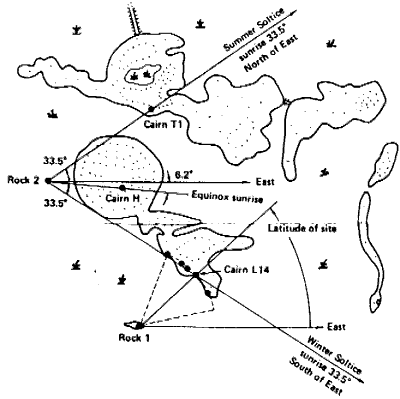 |
Science Frontiers ONLINE No. 34: Jul-Aug 1984 |
|
|
Ancient Wisconsin Astronomers
Prof. James Scherz claims to have discovered an ancient Indian calendar site in a marshy region near Wisconsin Rapids, Wisconsin. Scherz was led to the site by aerial photographs taken during a wetlands mapping program. Strange "islands" of higher land seen within the bog were found, upon terrestrial inspection, to be unusually steep, possibly artificial. Some were round, some four-sided; others were shaped like a fish, a rabbit, and a snake. [Wisconsin has many similar "effigy mounds" elsewhere.] Causeways connect some of these so-called islands.
The most interesting features of the islands, however, are prominent rocks and rock cairns. Braving hordes of mosquitoes and ticks, Scherz and an assistant mapped the islands, cairns, and rocks to determine if any astronomical alignments existed. Sure enough, the solstices and equinoxes were predictable from some of the alignments. Another alignment provided the site's latitude.
The exploration of this site is incomplete, and further information is expected. Quite possibly, the site is associated with the famous prehistoric coppermining activities around Lake Superior.
(Murn, Thomas J.; "Portage County Cairns: Wisconsin's Rockhenge," NEARA Journal, 18:50, 1984. Originally published in Wisconsin Natural Resources, vol. 7, no. 2. NEARA = New England Antiquities Research Association.)
Reference. Considerable detail on the prehistoric Lake Superior copper mining and the Wisconsin effigy mounds can be found in our Handbook: Ancient Man. For information on this book, visit: here.
 | Wisconsin calendar site, showing some of the cairn-rock alignments. The stippled islands are surrounded by marsh. |